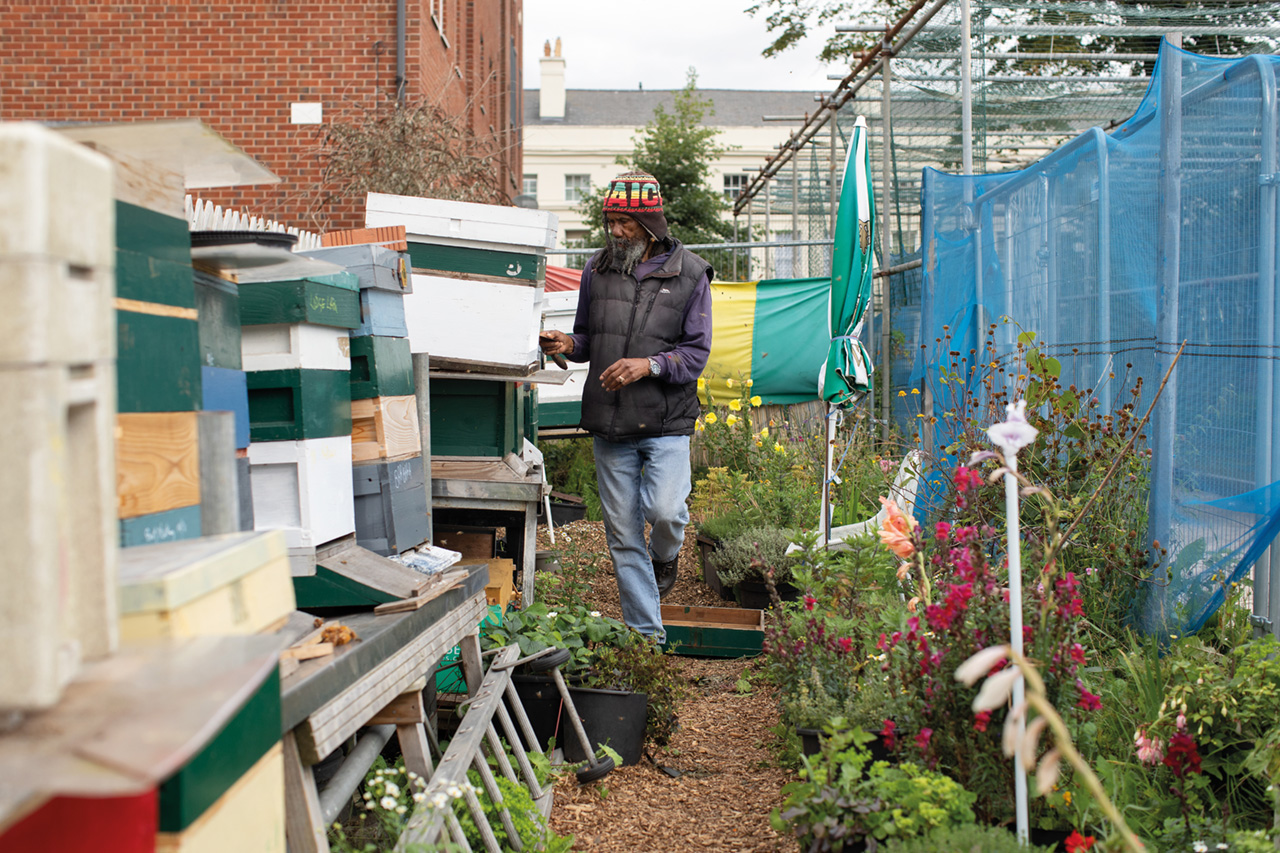Merseybee’s sweet sound
If you want to know about bees in Liverpool you speak to Barry. In words and photos, Ryan Ashcroft follows this well-worn trail to Toxteth – and inevitably finds a sting in the tale
On a warm summer’s morning I met Barry “The Bee Whisperer” outside the Caribbean Centre in Toxteth to see his community beehives. Barry migrated from Jamaica to Liverpool in 2001, bringing his passion for bees with him.
As a child, Barry would see bees pollinating among the vibrant flowers. “In Jamaica, the bees live in the hollow trees. I’d sit and watch them going in and out of their hive all day,” he says. Their activities fascinated him, and he later began to develop an understanding of a honey bee’s vital role in nature.
When he arrived in Liverpool 20 years ago, the limited number of honey bees in the city concerned him. As they were an endangered and declining species, Barry was determined to establish some hives in his neighbourhood and allow bees to flourish. He spent many years learning about them.
“Bees pollinate most of the crops we eat. Without them, we wouldn’t survive,” he says as we walk over to the hives at the Caribbean Centre. The murmur of buzzing fills the air as he unlocks the gate. Barry points to the collections of flowers sprawled across the pathway as we step into the narrow strip of land that the bees inhabit.
“I also love flowers, trees and all the nature around us that helps produce oxygen,” he beams as I try not to stand on any of the blossoms.
Barry visits the site every day, checking up on the bees and working on manual tasks. Although most of the hives belong to him, a few on the strip are kept by locals who were inspired to get involved after witnessing his efforts over the years. “We keep bees here for people who don’t have any space elsewhere,” he says.
In 2012, Barry earned his official stripes with full accreditation from the British Beekeepers Association. Now he gives his time up for anyone in the city willing to learn. “The bees are like my pets,” he explains. “I’m here every day looking after them, and if anyone else wants to learn how to set up a hive, I’ll teach.”
As we stand nattering, Barry lights a bee smoker as he prepares to open the hive to check on the queen bee and her progress laying eggs. The smoker calms the bees. When they sense danger, they release an alarm pheromone called isopentyl acetate from a gland near their stingers. This chemical wafts through the air and alerts other bees to be ready to attack. Smoking a beehive masks this pheromone, allowing the beekeeper to safely inspect a hive.
As the smoke pours into the hive, Barry looks back on the day he was titled the Bee Whisperer. In 2016 a large swarm of bees had descended on the outside wall of Pizza Express in Liverpool. Colonies containing tens of thousands of bees will produce new queens when the former queen gets too old. Just before these queens are about to hatch, the old queen leaves the hive and takes around 60 per cent of the colony with her to find a new home. Word got round that the biblical-looking mob of bees were intimidating pizza eaters and so Barry was called to move them on.
“Luckily I found the queen. I showed the crowd and the police and then put her in a box. Then all the bees came down.”
The Liverpool Echo published a piece with his photo. “That’s how I earned my name,” Barry laughs. “People still say it on the street.”
I’ve never seen a hive opened up before and it’s fascinating to watch a colony of bees all grouped together moving around as a unit. Barry tells me he doesn’t wear any protective clothing when working, just his “little woolly hat”. The bees seem to know him and refrain from jabbing him with venom. According to a new study, honey bees, which have only 0.01 per cent of the neurons that we do, can recognise and remember individual human faces. Unfortunately, as a new face on the block I’m deemed worthy of a few stings.
Despite a throbbing hand and a vision of a thousand bees swarming around to attack me, I watch Barry delicately look over the hive in search of the queen. The honeycomb walls are also inspected for honey, and I can see the golden liquid glistening against the wax. Barry tells me it takes around a year to gather enough honey to collect in jars – highlighting the amount of work required from the bees and Barry to create the end product.
To Barry, bees “resemble unity”. “When a bee finds nectar, it will return to the colony and show everyone else where the food is.”
After some time searching, the healthy queen is located. She’s shape differently from the worker bees, with a longer abdomen and legs. There’s something quite mystical about her presence among the rest of the bees. After a few seconds, she disappears back into the crowd and Barry continues with his duties – improving the framework of his main hive and making sure the rest of the beehives on the strip are all in working order.
“These days in Liverpool, you see bees flying around on the street, and I’m happy about that,” he says proudly as I buy a jar of honey from him and say my goodbyes.

Leave a reply
Your email address will not be published.